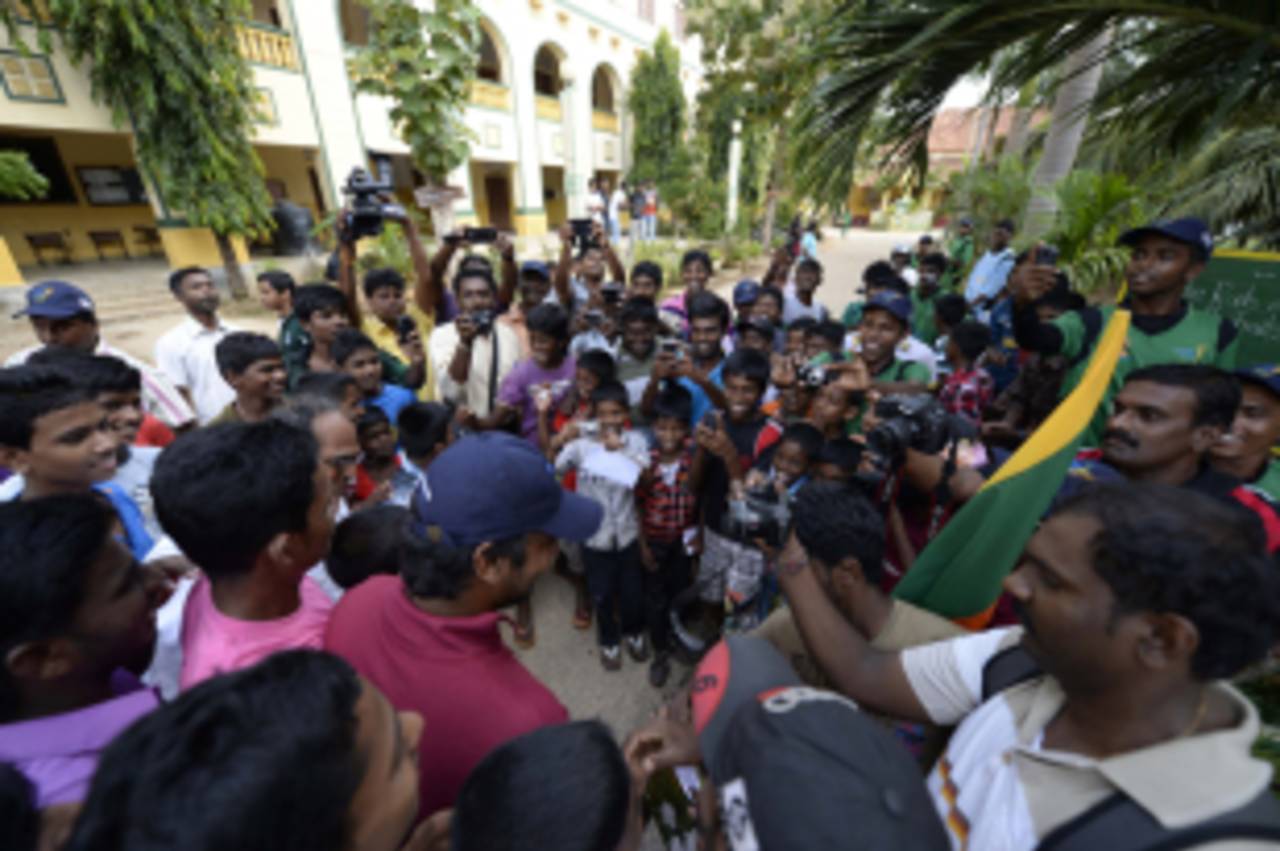"The capacity for cricket to bring unity and to bring communities together is huge,"
Kumar Sangakkara says as he surveys the Kilinochchi Central College grounds, where the local Under-19 team is playing their neighbours from the east coast of Sri Lanka. It has been four years since Sri Lanka's Civil War ended, and this town, the LTTE's former capital, was one of the hardest hit.
Many of the scars of conflict have been cleared out of sight. New stores, houses and factories have been erected, but right in the heart of town, a million-litre water tank lies on its side, half-buried in red earth, having been detached from its concrete stem by explosives, in the final months of the war. The gargantuan ruin brings Percy Shelley's "Ozymandias" to mind, but in Sri Lanka's dry zone where months pass without a drop from the heavens, perhaps it is better cast as a tribute to the resilience of the town's people.
Even here, though, as in Colombo and Kandy, where life had never been so harrowing, Sanga reigns supreme.
Cricketers are almost never mobbed in Sri Lanka. Despite their fame, they need no escape to non-cricketing lands to regain a sense of normalcy. Rangana Herath goes shopping by himself, and even Nuwan Kulasekara - Sri Lanka's present cult hero - attracts plenty of smiles, but rarely harassment.
Not so, though, for Sanga in the north. When he arrived in Kilinochchi for the Murali Cup on Saturday, spectators craned their necks in unison when the announcer made his presence known in Tamil, and looked around the venue. Within seconds he was surrounded, caps and bats shoved in his face, requests for photos flying in from every direction.
Sanga had left Colombo before dawn and walked 12 kilometres with Ian Botham, on a leg of Botham's charity walk, but at the end of a long day, he bore the crowd's adoring assault with a grin. They smiled plenty back at him. That was why he was here after all. The crush of giggling local girls and eager young men in Kilinochchi and Jaffna proved beyond doubt that no corner of the island is immune to Sanga's charm, or his cover drive.
"You see the boys from the north and east on the field, the dancers, the security forces, people from Colombo and the locals. You see teachers, elders and community leaders - they are all here because of cricket"
Sangakkara
Even Muttiah Muralitharan has not enjoyed so much irrepressible, unruly love among a people whose language he speaks and culture he identifies with. Sanga had made his last public trip to the north alongside
Mahela Jayawardene over a year ago, and Mahela drew a meagre following while Sanga posed, signed and talked his way into local hearts, lapping up the attention, loving every second.
Mahela had also visited the north on an earlier day of the Murali Cup, and this time his star shone brighter, not having to compete with the Sanga supernova. In Mankulam a group of eight-year-old boys in old t-shirts and bare feet squirmed metres away from him, too shy to approach for an autograph. So Mahela went to them instead, sitting on his haunches to greet them and staying long enough for a photo. The two cricketers' response to fame perhaps reveals a little about them as well; the more introverted Mahela has the common touch, but Sanga is a consummate celebrity.
But in both of them, and in others like Murali,
Ravindra Pushpakumara and
Sanath Jayasuriya, there is a heartfelt desire to see their fame and their sport foster healing and reconciliation in the north's communities. Thanks to their efforts with the Murali Cup and Jayasuriya's initiative as chief selector, five young cricketers from the north and east are on the verge of receiving central contracts from the board. That is not necessarily a reflection of the youngsters' talent, or potential, though they clearly possess plenty of each, but it is a message to the northern populace: "We are one people, and in cricket, if in little else, we will look after you."
"You see the potential of cricket in an event like the Murali Cup," Sanga says. "You see the boys from the north and east on the field, you see the dancers, you see the security forces, you see people from Colombo and the locals who have come to watch and support their teams. You see teachers, elders and community leaders - they are all here because of cricket. There's no talk of politics and no talk of anything other than watching this wonderful spectacle of sport. These children are sharing each other's experiences, sharing their effort out on the field, and putting on a display that all of us will enjoy."
Sanga returned to Colombo after 36 hours of the tournament. His last hour in the north was perhaps among the most hectic of his life, as he was surrounded by wave upon wave of unrelenting Jaffna devotees. If Sri Lanka's communities could rally together with the same fervour they reserve for the island's most cherished public figure, perhaps an underachieving nation will one day realise its immense potential.
Andrew Fidel Fernando is ESPNcricinfo's Sri Lanka correspondent. He tweets here
